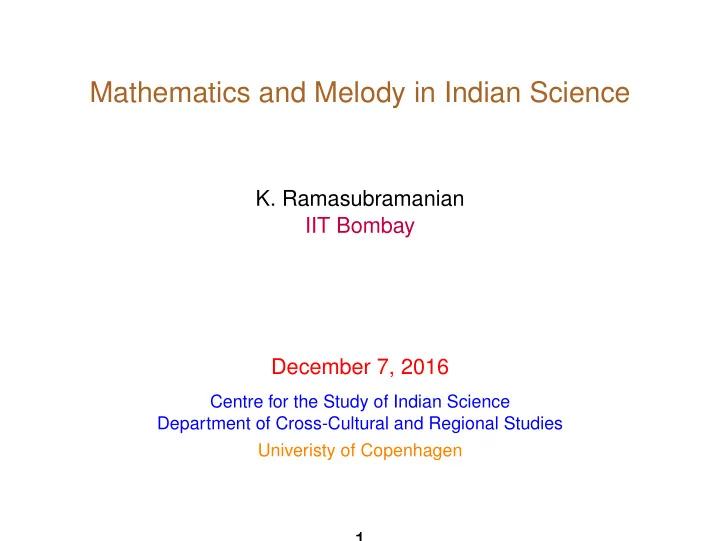

Mathematics and Melody in Indian Science K. Ramasubramanian IIT Bombay December 7, 2016 Centre for the Study of Indian Science Department of Cross-Cultural and Regional Studies Univeristy of Copenhagen 1
Introduction ◮ A perusal of literature around the world will show that it is common to compose works that describe tales of romance, beauty of nature, mythology, etc. in the form of poetry. ◮ But, scientific literature due to its use of technical jargon, as well as demands of brevity, clarity and precision is usually written in prose, interspersed with symbols/equations. ◮ This is all the more true of disciplines like physics, mathematics, etc. which involve numbers, symbols, and so on. ◮ However, in contrast to this general trend, a surprisingly large corpus of scientific literature in Sanskrit including works in mathematics, astronomy, etc. have been composed in verses that can be easily set to melodious music. ◮ Now we would like to highlight the skill of Indian mathematicians to weave the principles of mathematics into delightful verses, without losing clarity or precision. 2
Introduction ◮ Why did Indian mathematicians compose their works in the metrical form? ◮ Is it by choice, or ◮ Is it by compulsion ? (perhaps both!) ◮ Starting with ◮ representation of numbers ( khyughr . = 4.32 mil; Rama = 52) ◮ to presenting the various mensuration formulae ◮ to stating certain useful algebraic identities ◮ to describing formulae for finding sum of progressions ◮ to delineating the procedure for solving quadratic, and indeterminate equations (I and II order) ◮ to specifying the value of π ◮ to representing it in the form of an infinite series, ◮ to giving the derivative of ratio of two functions, all of them have been couched in the form if beautiful verses. 3
The surface area and the volume of a sphere �������������� ������������������������������������������� ���� � ������ �������� ����������������� ����������� ����� � ����������� ����������� � � ��������� ����������������� ��� ���������������� ���������� ���� ���� ��� ������� ��������� � ����������� ������������� �������������� ����������������� �� ���� A circle = circumference × a quarter of diameter = 2 π r × D / 4 π r 2 = A sphere = A circle × veda 4 π r 2 = V sphere = A sphere × D / 6 4 3 π r 3 = The demonstration of these results are found in his commentary on Siddh¯ anta´ siroman . i ( Bhuvanako´ sa ) called V¯ sya . asan¯ abh¯ a´ 4
Theorem on the square of chords In his ¯ ıya , ¯ Aryabhat .¯ Aryabhat .a has presents the theorem on the product of chords as follows (in half ¯ ary¯ a ): ������� ���������������� ������������������� ��� ����� �������������� �� ( ¯ Aryabhat .¯ ıya, Gan . ita 17) ◮ The words varga and q samvarga refer to square and product respectively. ◮ Similarly, dhanus and ´ sara refer to arc and arrow respectively. A Using modern notations the above ny¯ aya may be expressed as: E D B O Rsine 2 product of ´ = saras AE 2 DE × EB = C 5
� Problem involving solution of a quadratic equation Example drawn from Itih¯ asa ���������� ����������������� ������������������ � � ��� �� ��� ������ ���������� ��������������� ��������������� ��������������� ����� � �� �������������������������� � ������� ������� ��� ������������������� �������������������� ����� ������� ��������� ���� �������������������� ������������������ �������� ���� �������������� ���������� �� ◮ ���������� , ����������������� – Arjuna in order to slay Karn .a ◮ ��������������������� – a quiver of arrows ◮ ��������������� ��������������� – Avoiding with half of them ◮ ����� � �� �������������������������� – [He killed] all his horses with four times the square root of the arrows. ◮ ����� ������� ��������� � – used one arrow each . . . , umbrella, flag, and bow. ◮ �������� ���� �������������� ���������� – How many arrows did Arjuna discharge totally? 6
� Problem involving solution of a quadratic equation Example drawn from Itih¯ asa ���������� ����������������� ������������������ � � ��� �� ��� ������ ���������� ��������������� ��������������� ��������������� ����� � �� �������������������������� � ������� ������� ��� ������������������� �������������������� ����� ������� ��������� ���� �������������������� ������������������ �������� ���� �������������� ���������� �� ◮ Let ‘ x ’ denote the total number of arrows discharged by Arjuna. ◮ As per the information provided in the verse, √ 1 2 + 4 x + 6 + 3 + 1 = x (1) ◮ This reduces to the quadratic equation: √ x − 8 x − 20 = 0 , (2) whose solutions are √ x = ( 10 , − 2 ) . Of the two, we can only consider the + ve value, since the no. of arrows shot cannot be − ve. Hence, x = 100 is the answer. 7
Honey-bee problem ( solution to quadratic; ex. from nature ) �������� � ������������� � ������������� ��������������� �������������������������������� ���������������� ������ ��� ������������� � ������������ ��������������������� ����� ��� ���������� ����������� ��� �� � �� ��������������������� ���������� ��������� ������������������� � ��������� �� � x From a group of bees ( x ), square root of the half ( 2 ) went to the m¯ alat¯ ı tree. Again eight-ninth of the bees ( 8 9 x ) went to the ´ ı tree. Of the s¯ alin¯ remaining two, being absorbed in the fragrance [of the lotus], one got itself trapped inside the lotus he started moaning and wailing [from inside]. Responding to that, the beloved too moaned [from outside]. Now, tell me my beloved, the total number bees that were there. 8
Recommend
More recommend